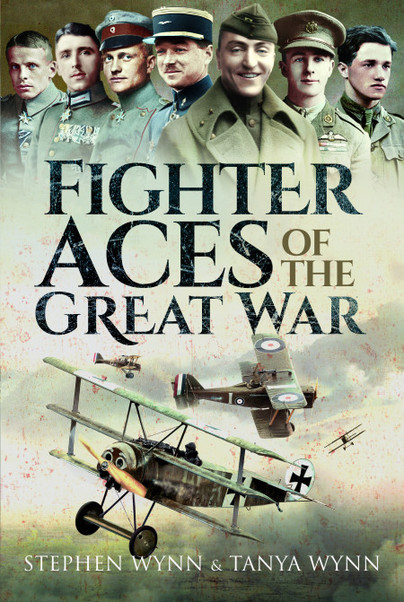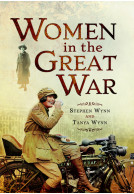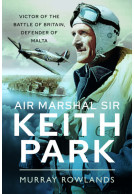Fighter Aces of the Great War (Paperback)
Imprint: Pen & Sword Aviation
Pages: 184
Illustrations: 40 black and white
ISBN: 9781473835207
Published: 15th May 2020
(click here for international delivery rates)
Order within the next 11 hours, 25 minutes to get your order processed the next working day!
Need a currency converter? Check XE.com for live rates
| Other formats available | Price |
|---|---|
| Fighter Aces of the Great War ePub (4.1 MB) Add to Basket | £6.99 |
History has recorded that the first ever powered flight took place at Kitty Hawk in America, on 17 December 1903 and was carried out by the Wright brothers, Orville and Wilbur, who were aircraft designers and manufacturers. By the time of the outbreak of the First World War, aviation was only eleven years old. The daddy of battlefield warfare until that point in time had been the cavalry, a position it maintained even as war was declared on the Western Front.
Aircraft were not initially seen as an offensive weapon and were instead used by both sides as observation platforms, or to take aerial photographs from. Even when they were eventually used in an offensive capacity, they did not have machine guns attached to them; if the crew wanted to open fire then they had to use a pistol or rifle.
As the war progressed so the use of aircraft changed from being an observational tool, to that of a fighter and bomber aircraft - something that had never been foreseen at the outbreak of the war. The book then looks at the fighter aces from all sides. These were pilots who had been credited with shooting or forcing down a minimum of five enemy aircraft, of which their were hundreds. While some of these aces survived, many of them were killed. The most famous fighter ace of all is without doubt the German pilot known as the Red Baron, Manfred von Richthofen.
"...will be of interest to readers seeking to start learning about World War One aviation..."
ARGunners.com
Read the review here
Featured in
The Hurricane, The Newsletter of the North Weald Airfield Museum Association - Summer 2021
Read all about the courage and heroics of the RFC/FAF and other Country's fighter pilots in aerial combat above the battlefields of the Western Front and elsewhere.
Western Front Assoc., Essex Branch Newsletter
Fighter Aces of the Great War were the ‘pin-up boys’ of their time, featuring in magazines and newspapers, also in the early movie films. The idea of declaring ‘aces’ was one way of picking out heroes for the media. – Highly Recommended
Firetrench
Read the full review here
This book helps the reader Remember some of the quite amazing men who flew above the battlefields of the Western Front. Their bravery is hard to comprehend given that flight development was in constant change, in its infancy. Going up in an aeroplane was in itself so dangerous, never mind then having to actually going in to battle with it. By telling the story of some of these key Fighter Aces, the author also re-tells this pivotal aspect of the war. As any interested person in the Great War will know, the use of air changed from initially being that of observation, to a different more combat role, and ultimately one which shaped the outcome of the war.
Jon Sandison
This one is much more interesting - It's the legendary stuff I was brought up on, reading about first world war dogfights and so on... Stephen Wynn and Tanya Wynn weave a good tale between them - absolutely enthralling...
Books Monthly
As featured on Scale Modelling Now
Scale Modelling Now
I went into this book thinking it would be a various biographies on those significant pilots in the Great War, but I was wrong it was much more than that. You pick up this book and your soon learning about the different countries that used aerial warfare, how they became pilots, what constituted getting a victory and in some cases it was harder than others or what seemed impossible. We also learn about training and in reality what little of it there was, life expectancy and the aircraft used in the aerial combat. In a way it shows how aerial combat was a bit hit and miss but then flying and combat had really only been going roughly ten years.
UK Historian
Although this is only a small book at 170 pages, it not a frivolous book or something that has been done seriously. In my opinion this book is detailed but to the point. But I actually like this about the book and which is why I really enjoy the work of the author Stephen Wynn, I have read a number of his book and they are always informative and entertaining. So often you can read books, especially on history which become boring and mechanical, but in my opinion when you have a good Stephen Wynn book you get a good well written book. Aerial warfare in the Great War has never really been a subject that I have covered before but I really enjoyed this book and I would heartedly recommend it to others.
Read the full review here
Flying was in its infancy when World War One began. Many saw airplanes as being of little or no use in battle. Poor training was offered because no instructors had combat experience. The perils and dangers hadn’t been considered. Tactics evolved and machine guns were added.
NetGalley, Terri Wangard
Pilots were lauded more than soldiers or sailors. Why the mythical status?
Brief biographical sketches are provided for many aces. Also lists of others, which were quickly skimmed over. Some had author intrusion, such as criticizing one man’s arrogance, another’s bad-mouthing of the enemies he killed, the right or wrong of counting observation balloons in the total of shot-down aircraft.
Interesting glimpses of life in the skies over WWI.
Rating: 5 out of 5 stars
NetGalley, Pat Lorelli
This book is a real good look into the air of World War One. The young men who would go on to fight and fly when just 11 years before the Wright Brothers had flown for the first time. Now you get a look at the young men from all countries that wanted to fly and would become aces. The back of the book the author lists all of the aces from every country and I do mean every country. Just looking at the list you see that it was truly a World War. A very good book.
A truly remarkable look at early air combat, this book gives you a great insight into the world of fighter pilots and how brave these young men were. Some might find this book a little dry with many numbers, but overall it is an intriguing look into a part of history that is not well known. As Georges Guynemer said " Until one has given all, one has given nothing. " That pretty much sums up the psyche of these courageous men.
NetGalley, Sandra Berryman
About Stephen Wynn
Stephen is a retired police officer having served with Essex Police as a constable for thirty years between 1983 and 2013. He is married to Tanya and has two sons, Luke and Ross, and a daughter, Aimee. Both Stephen’s grandfathers served in and survived the First World War, one with the Royal Irish Rifles, the other in the Mercantile Marine, whilst his father was a member of the Royal Army Ordnance Corps during the Second World War.
When not writing Stephen can be found walking his dogs with his wife, Tanya, at some unearthly time of the morning when most normal people are still fast asleep.
About Tanya Wynn
Stephen and Tanya Wynn are a husband and wife team. They have been married for twelve years and outside of writing enjoy the simplicities of life. They spend most mornings walking their four German Shepherd dogs at a time when most normal people are still sound asleep.
Animals in the Great War is the third book Stephen and Tanya Wynn have written together, having previously collaborated on Women in the Great War and A History of the Royal Hospital Chelsea 1682-2017. Stephen has written numerous titles in the military history genre over the years. His first book, Two Sons in a Warzone, was published in 2010. It is the true story of his sons first tours in Afghanistan. One of them was injured and the other was shot and wounded.
























